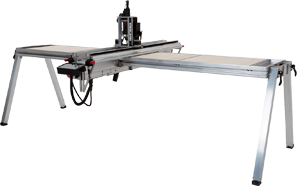Essential Principles - Mid-job events
Home » Knowledge Base » SmartBench Knowledge Base » Essential principles » Mid-job events
In the event of an emergency, you can instantly turn off the machine by pushing the power button on the Lower X Beam:
Only switch SmartBench off mid-job in an emergency, as this hard shutdown will make it unlikely to recover the job. |
Be aware that if SmartBench is switched off during a job:
The machine’s position will be lost. It will need to be rehomed and the job restarted.
If the tool is stuck in the material you will need to manually remove it from the workpiece, as per the instructions in the next part of this article.
You can pause SmartBench without losing position (depending on the situation) by pressing an Interrupt bar, or by pressing the pause button on the Console. |
Recovery after emergency power down
If SmartBench is powered down during a routing operation, the tool will stay in contact with the material, and will need to be manually extracted.
Rotate the Z Head pulley in a clockwise direction to raise the spindle up and out of the material.
Only use the Z Head pulley to raise the spindle if you have powered down SmartBench, and the tool is jammed in the stock material. |
A: Z head pulley
Once the spindle has been completely removed from the workpiece, it will be safe to move the X Beam away from the workpiece, and restart SmartBench.
Overview
SmartBench’s Upper X Beam has two Interrupt bars. When they are pressed, SmartBench will stop and pause all active jobs or operations.
If there is an obstacle on the surface of the stock material, the Interrupt bars will detect it and pause SmartBench.
A: Interrupt bars
What happens when an Interrupt bar has been pushed?
The “Interrupt bar pushed!” screen will appear on the Console.
Carefully check what caused the Interrupt bar to be pushed, and remove any obstacles. Check that the Interrupt bars are no longer depressed, and are moving freely. SmartBench will not allow you to resume if аn interrupt bar stays pushed. |
SmartBench will tell you when it is ready to resume, and you can cancel or resume the job.
When do I need to cancel the job?
Even if the Interrupt bars detect an obstruction, they might not be able to stop SmartBench’s motion before the obstruction causes an axis to stall.
If an axis has stalled, SmartBench will have lost position. In this case you need to cancel the job, rehome, and resquare SmartBench before resuming any other operations.
If the axis did not stall, the job can simply be resumed when the obstacle has been removed.
SmartBench will decelerate after the Interrupt bars have made contact with the obstacle. Therefore, stalls are more likely to happen when SmartBench is travelling faster, as it will travel further before it comes to a full stop. |
Examples of Interrupt bar events
It is important to diagnose the cause of the Interrupt bar push so that it can be resolved and handled appropriately.
Case study 1: Interrupt bars pushed for pausing a job
The Interrupt bar was pushed intentionally by the operator because the extraction was not working properly during the job.
This would be unlikely to cause a stall. After the operator has fixed their extraction issue, the job can be resumed.
Case study 2: Interrupt bars pushed by an fixed obstacle
The Interrupt bar was pushed by a screw which was not correctly fitted by the operator.
Even though SmartBench detected that there was an obstruction and stopped moving, it is likely that SmartBench still stalled in the process.
As it is hard to determine if the machine has lost steps and its position, it would be safest to cancel the job and start again.
Pausing the job
It may be necessary to pause a job on SmartBench. For example, to empty an extractor bag on a long job, or to remove debris from the machine.
To pause the job at any time, press the “pause” button in the top right of the Console screen.
SmartBench will pause the job, and slow down the spindle.
If you have told SmartBench to lift the spindle on pause, it will do so now.
Resuming the job
Once paused, press the “Play” button on the right hand side of the screen to resume the job.
If you need to resume a job after another pausing event, such as an interrupt bar push or spindle overload, press the same green “Play” button. |
Cancelling the job
Pause the job, and then press the “X” button on the left hand side of the screen to cancel it.
Press “Yes” to confirm the cancellation of the job.
SmartBench does not have an automatic tool change facility, so you will need to manually change the tool in between running job files.
If your project requires multiple tools to complete it, ensure that your project is exported as separate job files for each tool (if your CAD/CAM software does not do it automatically).
Do not power off the SmartBench at any time in the tool change procedure. If it is powered off it will lose its current XYZ position and will need to be rehomed. This may lead to inaccuracies in the work due to unavoidable variations in the home position. |
Fitting a tool incorrectly can cause serious damage to SmartBench. If you are stuck at any point, click on the links throughout this article to learn more, or click here to go directly to our detailed masterclass about tool change procedure. |
Unload the spindle from the Z Head
The first thing you will need to do is remove the Spindle Motor from the Z Head to gain access to the tool. Click here for instructions on how to do this.
Load your new collet and tool
Get your new tool, and select the collet that you will use with it. Click here to learn more about choosing the right collet.
Once you have your chosen tool and the correct collet, remove the current tool and collet from the Spindle motor.
Fit the new collet into the Spindle motor. Click here to learn more about how to do this.
When the collet is properly seated in the Spindle motor, fit the tool. It’s important to get this right, so click here to learn how to do this safely and correctly.
Reload the Spindle into the Z Head
Fit the Spindle Motor back into the Z Head. Click here for instructions on how to do this.
Set up the next job
You will need to set a new Z Datum, as the position of the tool will have changed. Click here to learn more about this.
It’s important to note that your Z Datum will need to reference either the top or bottom of your material depending on what you specified in the job file |
Set your new Z datum before loading the job to avoid any error messages due to conflicts with SmartBench’s working boundaries. |
Load the new job file for the new tool on your SmartBench Console. Click here to learn more about this.
If you need to do anything else to set up for your next job, do so now.
Otherwise, it’s time to press go and start the next job!
On the SmartBench Console file run screen, there are buttons to adjust your feed rate during the job.
With SmartBench Precision and PrecisionPro, you can also adjust the spindle speed.
These buttons can be used to fine tune your feeds and speeds mid-job, to get the best results and maximise tool and brush life.
You can go down to 5% and up to 200% of your original feed rate or spindle speed, giving you a large range of adjustment to make your job perfect every time.
Click here to learn more about choosing the correct feeds and speeds for your job.

